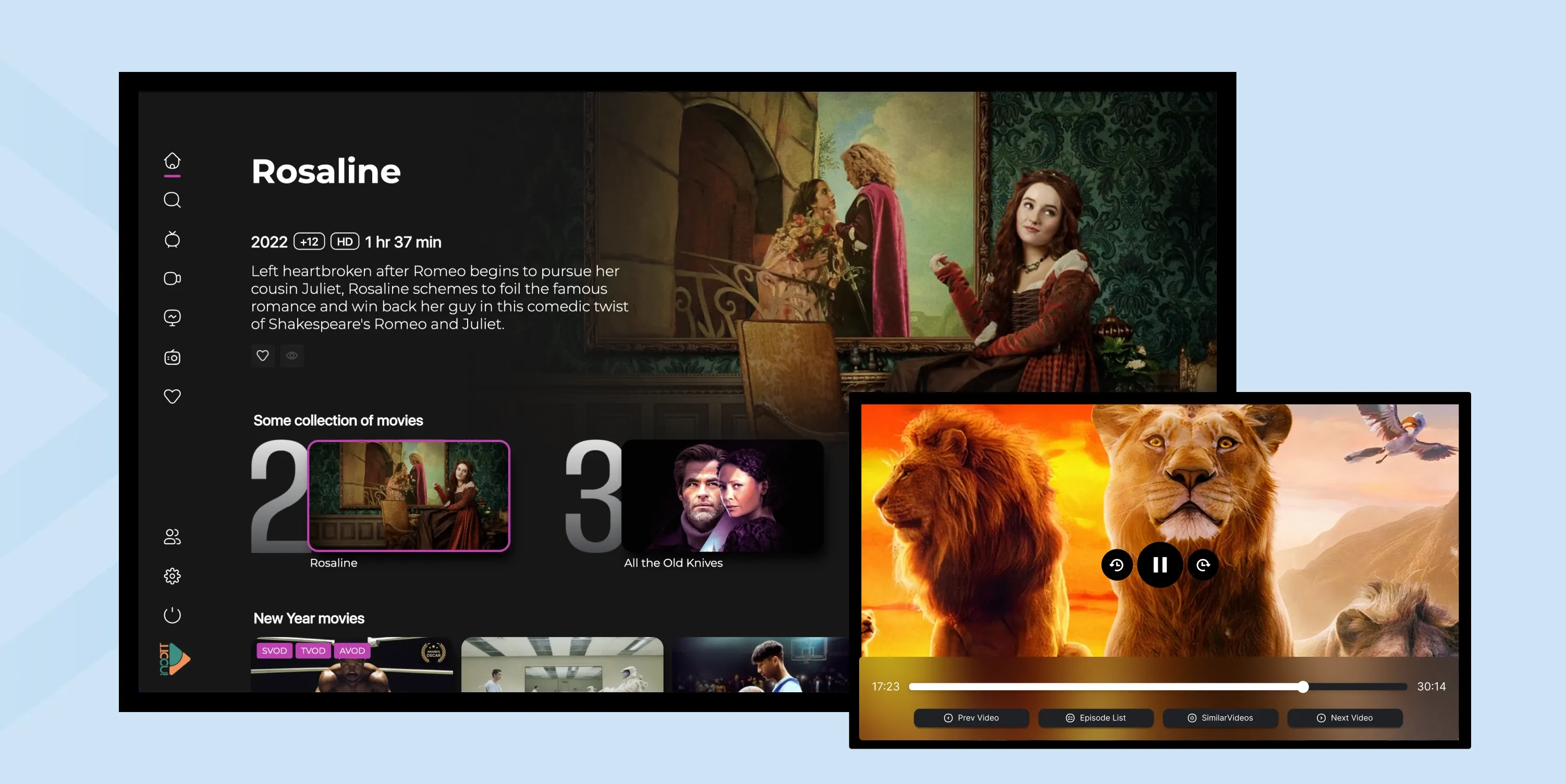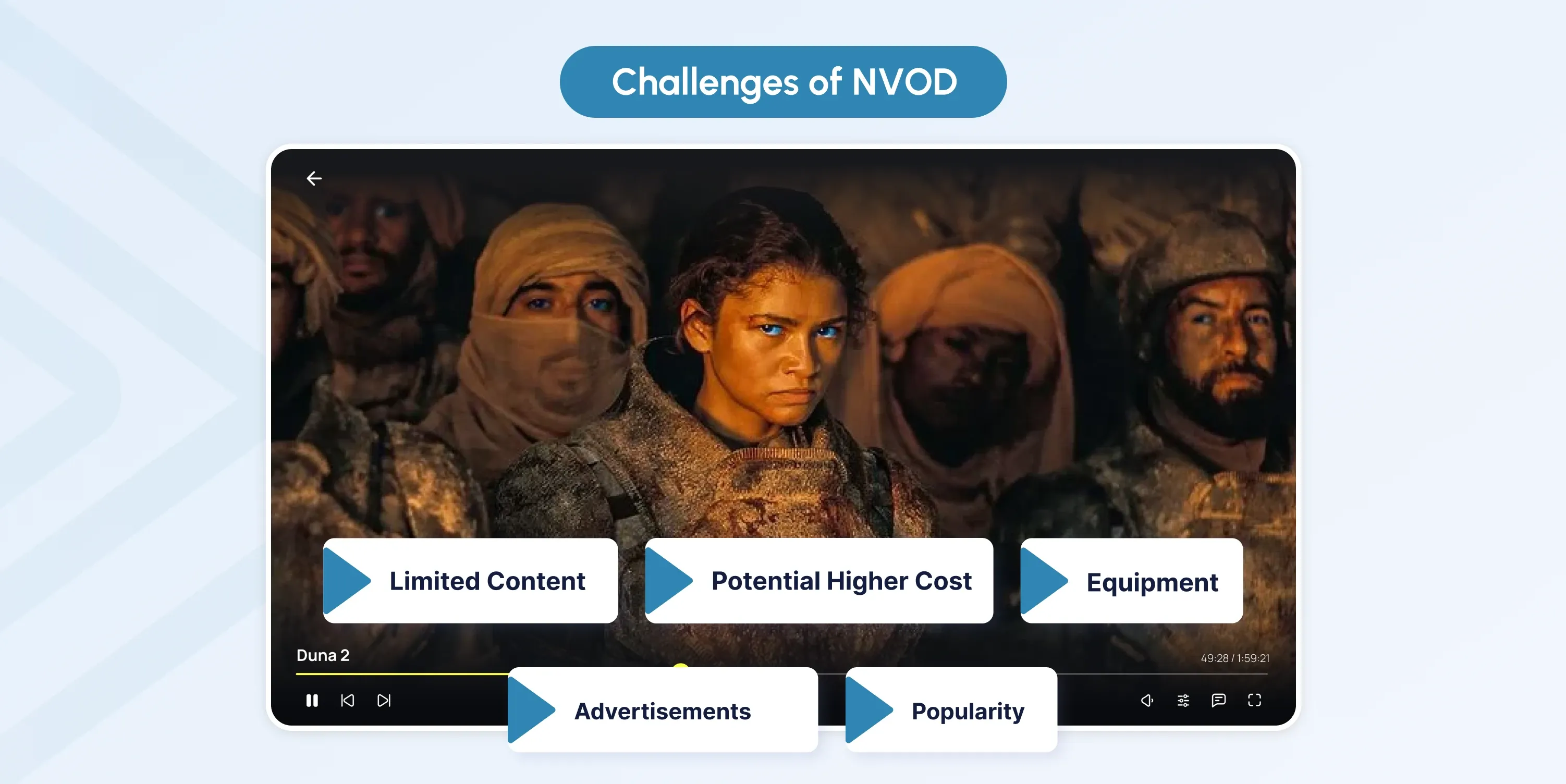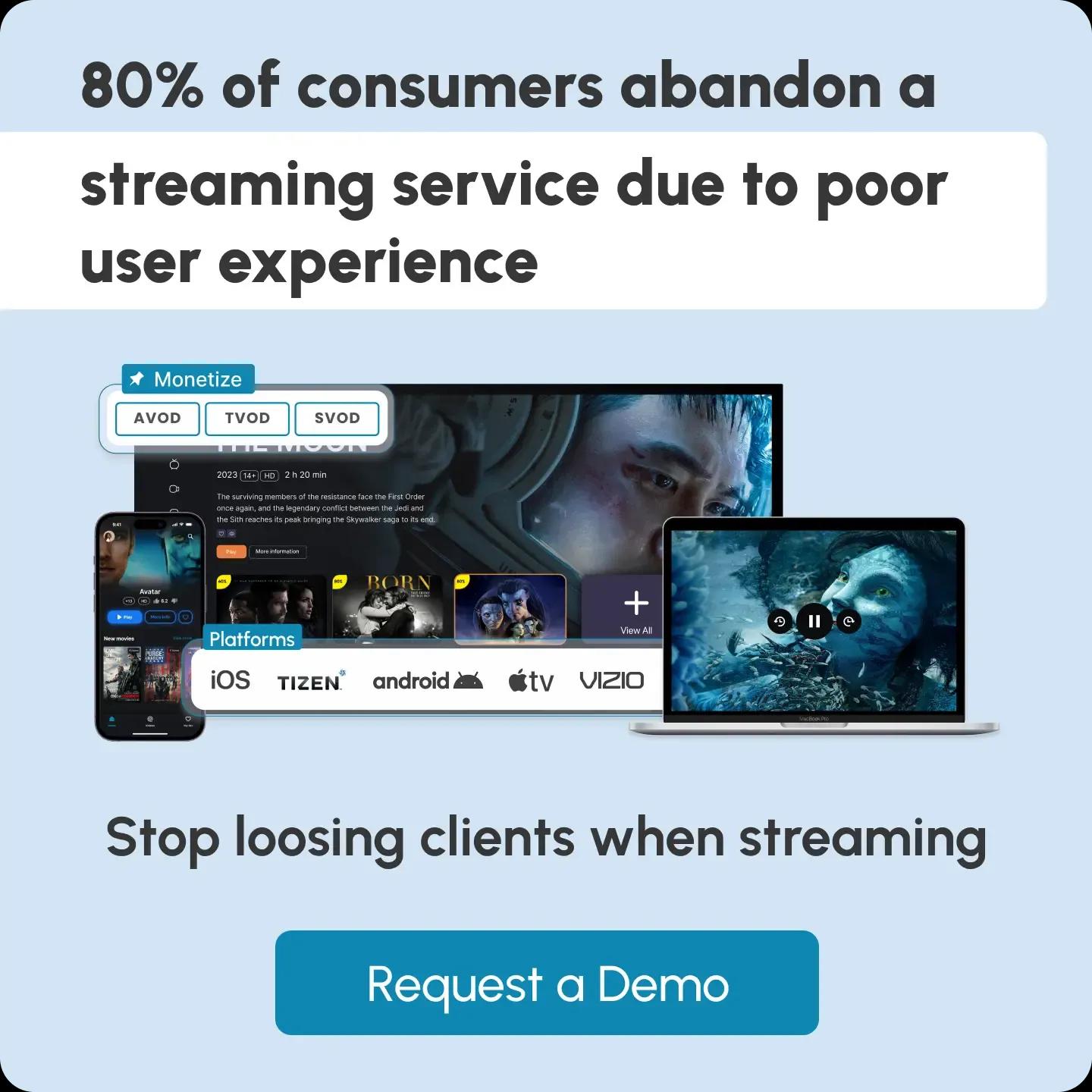
What is NVOD? Advantages, Examples and Challenges
What is NVOD? Before we answer that question, let's learn why it exists. Picture your viewer coming home after a long day, all ready to de-stress with their favorite TV show or movie. But when they turn on the TV, they realize they’ve missed the beginning by half an hour. Frustrating, right?
This is where NVOD (Near Video on Demand) comes into play. Unlike popular on-demand services like Netflix, Hulu, and Prime Video, which allow users to watch content anytime from vast libraries, NVOD offers a more structured approach.
It allows cable and satellite users to watch scheduled content with multiple start times throughout the day, offering near-instant access without the complete flexibility of full VOD services.
In this article, we’ll explore NVOD, its advantages, and how it compares to other streaming services.

Key Takeaways
- NVOD is a traditional way for broadcasting services to provide a limited content-on-demand viewership for their audience. However, this content is restricted and only available at specific times and channels.
- Unlike traditional VOD models, NVOD content comes with intervals to show advertisements to viewers, which can affect the overall user experience.
- NVOD is a more cost-friendly option for audiences who don’t watch movies and TV very often and only want to watch specific movies and shows.
- NVOD channels are great for locations/areas known to have low internet speed or no internet at all. Older generations may also prefer NVOD TV compared to complicated VOD services.
- Unlike VOD services, NVOD doesn't have any interactive elements (pause, rewind, skip, and fast-forward), which can reduce the viewing experience.
- NVOD channels sometimes have exclusive movies and shows that aren’t available on other channels for regular users.
What is NVOD?
NVOD (Near Video on Demand) is a hybrid model that blends traditional cable and satellite broadcasting with on-demand convenience. It pre-schedules content, like movies or events, and broadcasts it on multiple channels at staggered start times, allowing viewers to watch with minimal wait time.
Users watch content on a fixed schedule, but with multiple viewing windows throughout the day, making it a time-limited on-demand service.
Now, service providers can use NVOD channels to create a selection of movies, shows, etc., available at different times throughout the day on various channels. This allows viewers to watch their favorite content when they have time without missing anything.
However, it's important to note that NVOD broadcasting often operates within short time frames, typically within 15 to 30 minutes of the scheduled broadcast. Viewers may need to switch to another channel to catch their show or movie when it starts.
Advantages of NVOD
Below are some key benefits that NVOD brings to traditional broadcasting, making it an appealing option for both viewers and service providers:
1. Flexibility
Unlike traditional broadcasting, NVOD allows users to choose from multiple starting times for their favorite content. This flexibility lets viewers watch at their own pace, creating a more relaxed and satisfying viewing experience. It combines the convenience of near-instant access with the structure of scheduled programming, offering a middle ground between traditional TV and full VOD services.
2. Content Cost
Many NVOD channels allow viewers to access premium content at a lower price than traditional pay-per-view options. However, these services often include advertisements, which help offset the lower costs.
3. Exclusive Content
Depending on the service provider, NVOD services also have exclusive movies and shows unavailable on or through other channels. This makes it a valuable option for viewers seeking specific titles that might not be available for viewing.
4. Bandwidth
Service providers using NVOD can schedule content at staggered intervals, which allows for more efficient bandwidth management. By spreading out start times, NVOD helps reduce the strain on servers compared to traditional services that require constant streaming for large audiences.
5. Appeal
Traditional broadcasting services that offer NVOD remain highly popular in areas with low internet speeds or no internet access. For viewers relying on cable or satellite, NVOD is a valuable alternative to streaming services.
NVOD vs. SVOD vs. TVOD vs. AVOD
To understand what NVOD is and how it compares to other services, we first need to explore how it works.
This table provides a detailed comparison between NVOD, SVOD, TVOD, and AVOD services, highlighting their key differences.
| Model | Service Providers | Timing | Interactivity | Content | Cost for Users |
|---|---|---|---|---|---|
| NVOD | Cable TV providers, Satellite TV operators | Scheduled, pre-set intervals | Low – users choose from available start times | Pre-selected movies, sports, or events | Pay-per-view per event or movie |
| SVOD | Streaming platforms like Netflix, Disney+, and Amazon Prime Video | On-demand, anytime access | High – users can choose and watch content anytime | Extensive content library including movies, series, and originals | Monthly or yearly subscription fee |
| TVOD | Digital stores like iTunes, Google Play Movies, and Amazon Prime Video rentals | On-demand, immediate access after purchase | High – users select and pay per content | Individual movies, series, or special content | One-time payment per rental or purchase |
| AVOD | Free streaming services like YouTube, Pluto TV, and Tubi | On-demand, anytime access | High – users can watch freely but with ads | Licensed movies, shows, and user-generated content | Free (ad-supported) |
NVOD Challenges
Despite its advantages, NVOD still faces several limitations:
Limited Content
NVOD content is only available at specific times with a set schedule. This can be inconvenient for users who cannot watch their favorite shows or movies during the available time slots.
Additionally, NVOD TV typically offers a smaller selection of content than VOD services, which often have extensive libraries of diverse options that can be accessed anytime. This lack of flexibility can be a drawback for viewers looking for a more on-demand experience.

Potential Higher Cost
While NVOD is commonly considered more cost-effective than VOD services, the costs can sometimes exceed those of subscription-based services, especially if viewers are charged per view.
Equipment
NVOD services often require specific equipment, such as cable boxes or satellite receivers, to access shows and movies. This dependency on hardware can limit the service's accessibility and impact the overall user experience, especially for those without the necessary setup.
In contrast, VOD services are widely accessible and convenient, requiring only an internet connection and a compatible device.
Advertisements
Despite the convenience of NVOD, traditional broadcasting services often include advertisements during shows and movies. These interruptions can distract and disrupt the viewing experience, especially for those who prefer uninterrupted, immersive content.
Popularity
Streaming services have become dominant in the entertainment market due to their convenience, user-friendly platforms, and vast content libraries. With competitive pricing and the option for ad-free viewing, they offer a seamless experience for users who prefer on-demand content.
As a result, NVOD services are becoming less relevant, especially among younger audiences accustomed to instant access and flexibility. A 2023 study revealed that VOD services generated over $70 billion in revenue, highlighting the shift toward on-demand viewing and the growing demand for streaming platforms over traditional broadcast models like NVOD.
Conclusion
So, what is NVOD? It’s a service designed to bring flexibility and convenience to viewers who prefer traditional broadcasting methods for their entertainment.
In the past, watching your favorite movies, shows, or documentaries meant waiting for them to air, and if you missed the broadcast, you had to wait for a re-run. NVOD improved upon this by offering multiple viewing windows, making content more accessible without being fully on-demand.
While NVOD served its purpose well, it had its limitations in terms of content availability and scheduling. However, it laid the groundwork for the modern streaming services that have become increasingly popular, especially among younger audiences.
As the market evolves, it's crucial to stay ahead. If you're looking for advanced, flexible, and user-friendly OTT solutions, inoRain can help you navigate the future of streaming. Contact us today to elevate your streaming capabilities.
FAQ
What is NVOD?
NVOD (Near Video on Demand) is a digital broadcasting system that delivers scheduled content. Viewers can choose from various programs on different channels, each starting at different times, allowing them to watch TV when it suits them.
Is NVOD affordable?
NVOD can be considered less affordable than more modern streaming models like SVOD or AVOD. While NVOD might have been cheap for occasional users, its cost can quickly surpass today's more economical subscription or ad-supported options.
What is an example of NVOD?
An example of NVOD is the pay-per-view system used by cable and satellite TV providers, such as Comcast or DirecTV, where movies or events (like sports) are scheduled to play at multiple times throughout the day. Users can choose from a selection of content and watch it at one of the scheduled start times, instead of being able to watch it immediately on-demand.
Co-founder / CTO
Armen is the CTO and Co-Founder of inoRain OTT and Co-Founder of HotelSmarters, specializing in advanced streaming technologies, OTT strategy, and interactive TV systems. He builds scalable end-to-end video delivery solutions and drives technical innovation across hospitality and streaming platforms, bridging complex engineering with practical business impact.

OTT Advertising: Types, Best Practices, and Strategies
Over-the-top (OTT) advertising has transformed how brands connect with consumers.

VPlayed Alternatives: inoRain vs. VPlayed
Explore inoRain as a VPlayed alternative, comparing features, pricing, and OTT solutions to find the best platform for your streaming needs.

Custom OTT Platform Development: How to Start an OTT Business
This guide will walk you through everything you need to know about the OTT platform development.

